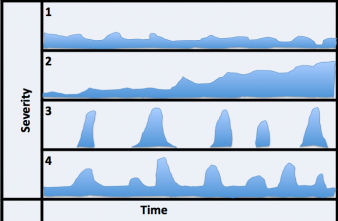Assessment
Assessment of the adolescent or adult with headache follows much what has been described previously for children. The main difference is that there are some age-specific causes to be considered.
Nice describe a stepwise approach to assessment:-
- Asses the possibility that more than one headache disorder is present
- Assess for symptoms of:-
- Serious secondary causes
- Medication overuse
- Tension-type and migraine headaches
- Examine for secondary causes
- If the cause cannot be diagnosed
- Use a headache diary
- Consider referral for assessment
The initial history should ask as a minimum
- Is there one or more than one type of headache?
- When did they start?
- How frequent?
- How long does it last?
- Site of headache? – Is there more than one site?
- Intensity of pain?
- Precipitating factors?
- What makes the pain worse?
- What makes the pain better?
- Medicine use/overuse?
- Associated symptoms
- Visual disturbance (when?)
- Nausea or vomiting
- Dizziness or lightheaded
- Abdominal pain
- Well between attacks?
Examination should include
- Measurement of blood pressure.
- Palpation of the temporal arteries, if the person is more than 50 years of age.
- A neurological examination, including fundoscopy for papilloedema.
- Examination of the neck for muscular tenderness, stiffness and limitations of movement.
A headache diary can be downloaded here
A visual analogue scale for severity of pain can be downloaded here
Patterns of headaches

Pattern 1 is known as chronic non- progressive. It is the pattern seen with the primary headaches known as tension-type. Although tension type headache can indeed be psychogenic in its aetiology, many other factors can be involved.
Pattern 2 is known as chronic progressive. This is a red flag pattern and should trigger prompt referral for investigation. It is seen in Hydrocephalus, Brain Tumour, Brain Abscess and Benign Intracranial Hypertension.
Pattern 3 is typical of migraine; further classification will depend on other symptoms noted in the headache diary.
Pattern 4 is acute on chronic non-progressive and the possibility of co-existing migraine with background tension headache should be considered.
BASH list the warning features in the history as:-
- Headache that is new or unexpected in an individual patient
- Thunderclap headache (intense headache with abrupt or “explosive” onset)
- Headache with atypical aura (duration >1 hour, or including motor weakness)
- Aura occurring for the first time in a patient during use of combined oral contraceptives
- New onset headache in a patient older than 50 years
- New onset headache in a patient younger than 10 years
- Persistent morning headache with nausea
- Progressive headache, worsening over weeks or longer
- Headache associated with postural change
- New onset headache in a patient with a history of cancer
New onset headache in a patient with a history of HIV infection.
Feedback
To provide feedback on this module, please follow this link, you will be a taken to a short questionnaire which will take 5 minutes to complete.

